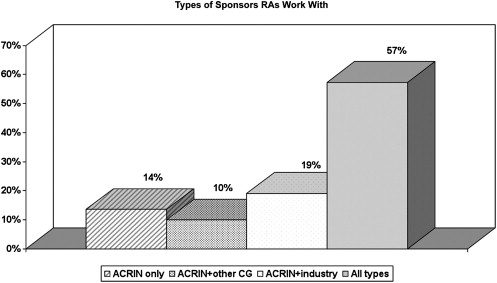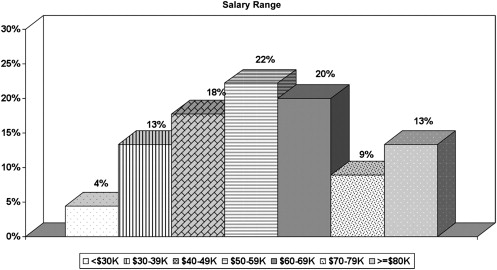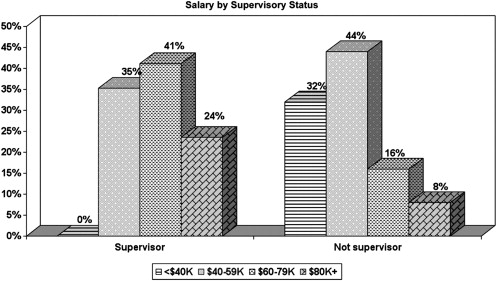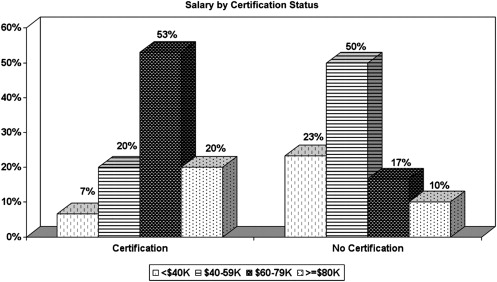Rationale and Objectives
As one of the newest cooperative groups funded by the National Cancer Institute in 1999, the American College of Radiology Imaging Network (ACRIN) is interested in conducting successful clinical research programs and pursuing quality research. The ACRIN Research Associate (RA) committee was formed in 2000 and felt it important to better understand the demographics, duties, needs, and concerns of ACRIN RAs. Therefore, in 2008, the committee conducted a survey of ACRIN RAs regarding these issues.
Materials and Methods
The survey instrument consisted of 33 multiple choice questions covering demographics, salary, job satisfaction, work load, educational background, and training. RAs completed the survey electronically in June 2008.
Results
A total of 110 responses were received. All regions of the United States were represented. The years of experience and salary ranged widely from <1 year to 28 years and ≤$20,000 to ≥$80,000 per year. The majority of respondents held at least a bachelor’s degree, with many having previous health-related clinical training; only a small percentage of respondents having had formal training in research.
Conclusion
Our survey summarizes the demographics and educational background of the research associates within ACRIN. This may help administrators understand the needs and characteristics of RAs participating in cooperative group research. In today’s environment with tight regulatory control, it may become necessary to improve educational standards or require certification through one of the professional research organizations.
Cooperative groups (CG) are major sponsors of oncology research in the United States, Canada, and Europe and enroll more than 22,000 patients onto clinical trials yearly . Most university-based research programs include affiliation with at least one cooperative group and in many cases more than one. CGs are primarily funded by the National Institutes of Health using the cooperative agreement funding mechanism (U01 grants). The American College of Radiology Imaging Network (ACRIN) is one of the newest CGs, conceived in 1999, and funded by the National Cancer Institute. To date, ACRIN has opened 30 clinical studies and has enrolled more than 76,550 subjects .
Research Associates (RAs), also known as clinical research coordinators, play a critical role in supporting a successful clinical research program and ensuring the quality of research within the CG setting. RAs’ responsibilities include preparing institutional review board submissions, maintaining regulatory documents, screening potential research participants, participating in the informed consent process, scheduling tests and treatments, completing and submitting case report forms, following the participants in accordance with protocol requirements, and ensuring compliance with hospital and federal regulations and Good Clinical Practice.
Get Radiology Tree app to read full this article<
Materials and methods
Get Radiology Tree app to read full this article<
Table 1
Survey Instrument Questions
Question 1. Are you an RA for other research groups/sponsors as well as ACRIN? 2. How long have you worked as a research associate? 3. How were you trained for your position? 4. What is your background? 5. Are you certified by SoCRA, ACRP, or CCDM? Please indicate your certification. 6. What other duties/responsibilities do you have in addition to your work as a research associate? 7. How many other RAs are there working in your department/section? 8. Do you supervise any other employees? If yes, what are the positions of the employees you supervise? 9. What was your work experience immediately prior to becoming a RA? 10. Describe your work status. 11. What is your current salary range? 12. In which state are you currently employed? 13. Type of institution in which you work: 14. What do you think is the minimum education level that should be required of RAs? 15. Do you think a SoCRA or ACRP certification should be required of RAs? 16. What do you feel are the most challenging duties of being an ACRIN RA? 17. How long did it take for you to feel comfortable with your position as an ACRIN RA? 18 Do you think that on-the-job experience is sufficient training to be a successful RA for ACRIN? 19. Are you aware of the ACRIN RA web link located on the ACRIN home page? 20. Have you accessed the RA link on the ACRIN website to locate a mentor or resource person? 21. Have you ever read the ACRIN RA newsletter? 22. How many patients on average do you enroll onto research studies per year? 23. How many patients (on average) do you follow and submit data for at lease once a year? 24. How many patients, on average, does your entire department/section enroll per year? 25. Do you meet/interact regularly with the ACRIN study investigator designated at your site? If yes, how often do you meet/interact? 26. Do you feel your ACRIN study investigator offers you the support necessary to conduct your job efficiently? 27. Do you regularly participate on ACRIN conference calls? 28. Do you attend ACRIN annual meetings? 29. What kind of programs would you find helpful at annual meetings? 30. Do you have the hardware (computer/modem) with adequate Internet capability available for use at your site? 31 Please rate your skills regarding use of the Internet or web browser. 32. Do you think that you will need training in the use of the Web service in order to learn how to access ACRIN protocols? 33. What aspects of ACRIN RA training are currently working well? How can we improve our training processes and resources?
ACRIN, American College of Radiology Imaging Network; RA, ACRIN Research Associate; SoCRA, Society of Clinical Research Associates; ACRP, Association of Clinical Research Professionals; CCDM, Certified Clinical Data Manager, Society of Clinical Data Management.
Get Radiology Tree app to read full this article<
Get Radiology Tree app to read full this article<
Results
Get Radiology Tree app to read full this article<
Demographics
Get Radiology Tree app to read full this article<
Get Radiology Tree app to read full this article<
Salary
Get Radiology Tree app to read full this article<
Get Radiology Tree app to read full this article<
Background, Education, and Training
Get Radiology Tree app to read full this article<
Get Radiology Tree app to read full this article<
Get Radiology Tree app to read full this article<
Certification
Get Radiology Tree app to read full this article<
Get Radiology Tree app to read full this article<
Duties
Get Radiology Tree app to read full this article<
Get Radiology Tree app to read full this article<
Table 2
Responses to the Question: What do you Feel are the Most Challenging Duties of being an ACRIN RA? ∗
Response Percent of Responders Paperwork 45 Queries 33 Case report forms/data entry 33 Institutional review board 33 Time management 25 Audits 24 Financial issues 24 Subject retention 24 Working with investigator 19 Staffing 16 Patient interaction 10 Conference calls 10
ACRIN RA, American College of Radiology Imaging Network Research Associate.
Get Radiology Tree app to read full this article<
Get Radiology Tree app to read full this article<
Resources Available for the ACRIN RA
Get Radiology Tree app to read full this article<
Get Radiology Tree app to read full this article<
Get Radiology Tree app to read full this article<
Discussion
Get Radiology Tree app to read full this article<
Salary
Get Radiology Tree app to read full this article<
Get Radiology Tree app to read full this article<
Education and Training
Get Radiology Tree app to read full this article<
Certification
Get Radiology Tree app to read full this article<
Staffing Levels/Duties
Get Radiology Tree app to read full this article<
Conclusions
Get Radiology Tree app to read full this article<
Get Radiology Tree app to read full this article<
References
1. Cancer Therapy Evaluation Program, Clinical Trials Cooperative Group Program. Available at: http://www.cancer.gov/cancertopics/factsheet/NCI/clinical-trials-cooperative-group . Accessed March 23, 2010.
2. ACRIN.org . Available at: http://www.acrin.org . Accessed March 23, 2010.
3. Salenius S., Beccaria L., Cobb C., et. al.: The Research Associate Committee of the ACR Imaging Network. J Am Coll Radiol 2006; 3: pp. 45-51.
4. Society of Clinical Research Associates. SoCRA 2004 salary survey. In: Peter J. DePaulo, ed. Final report; Chalfont, PA, 2005.
5. Association of Clinical Research Professionals. 2003 member compensation and benefits survey. Final report; ACRP, Alexandria, VA, 2003.
6. ACRIN Research Associates Committee. Available at: http://acrin.org/COMMITTEES/RESEARCHASSOCIATES/tabid/117/Default.aspx . Accessed March 23, 2010.



